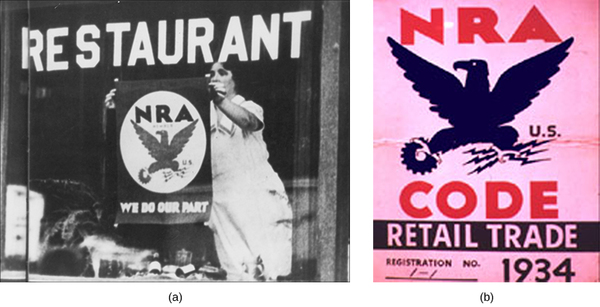| << Chapter < Page | Chapter >> Page > |
A new government agency, the National Recovery Administration (NRA), was central to this plan, and mandated that businesses accept a code that included minimum wages and maximum work hours. In order to protect workers from potentially unfair agreements among factory owners, every industry had its own “code of fair practice” that included workers’ rights to organize and use collective bargaining to ensure that wages rose with prices ( [link] ). Headed by General Hugh S. Johnson, the NRA worked to create over five hundred different codes for different industries. The administration of such a complex plan naturally created its own problems. While codes for key industries such as automotive and steel made sense, Johnson pushed to create similar codes for dog food manufacturers, those who made shoulder pads for women’s clothing, and even burlesque shows (regulating the number of strippers in any one show).

The NIRA also created the Public Works Administration (PWA). The PWA set aside $3.3 billion to build public projects such as highways, federal buildings, and military bases. Although this program suffered from political squabbles over appropriations for projects in various congressional districts, as well as significant underfunding of public housing projects, it ultimately offered some of the most lasting benefits of the NIRA. Secretary of the Interior Harold Ickes ran the program, which completed over thirty-four thousand projects, including the Golden Gate Bridge in San Francisco and the Queens-Midtown Tunnel in New York. Between 1933 and 1939, the PWA accounted for the construction of over one-third of all new hospitals and 70 percent of all new public schools in the country.
Another challenge faced by the NRA was that the provision granting workers the right to organize appeared to others as a mandate to do so. In previously unorganized industries, such as oil and gas, rubber, and service occupations, workers now sought groups that would assist in their organization, bolstered by the encouragement they now felt from the government. The Communist Party took advantage of the opportunity to assist in the hope of creating widespread protests against the American industrial structure. The number of strikes nationwide doubled between 1932 and 1934, with over 1.5 million workers going on strike in 1934 alone, often in protests that culminated in bloodshed. A strike at the Auto-Lite plant in Toledo, Ohio, that summer resulted in ten thousand workers from other factories joining in sympathy with their fellow workers to attack potential strike-breakers with stones and bricks. Simultaneously in Minneapolis, a teamsters strike resulted in frequent, bloody confrontations between workers and police, leading the governor to contemplate declaring martial law before the companies agreed to negotiate better wages and conditions for the workers. Finally, a San Francisco strike among 14,000 longshoremen closed the city’s waterfront and eventually led to a city-wide general strike of over 130,000 workers, essentially paralyzing the city. Clashes between workers, and police and National Guardsmen left many strikers bloodied, and at least two dead.

Notification Switch
Would you like to follow the 'U.s. history' conversation and receive update notifications?